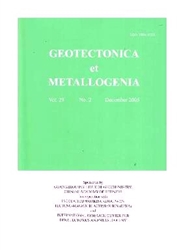GEOCHEMICAL CHARACTERISTICS OF THE EARLY MESOZOIC GRANODIORITES AND THEIR TECTONIC IMPLICATIONS
作者:PENGTouping,XIXianwu,WANGYuejun,PENGBingxia,JIANGZhimin
摘要:The early Mesozoic granodiorites (ca. 165 Ma) in the northeastern Hunan Province (NEH) have SiO2=65.4-69.65%, K2O/Na2O=0.95-1.38 and K2O+Na2O>6%, A/CNK=0.96-1.13 and belong to metaluminous high-K calc-alkaline series. They are characterized by LREE and LILEs enrichment, and HFSE depletion with slightly negative Eu anomalies (Eu/Eu*=0.62-0.90). The initial 87Sr/86Sr ratios are in range from 0.711458 to0.717461, and εNd values vary from -9.4 to -12.3, distinct from those of the contemporaneous granodiorites mantle-derived from the Southeastern Hunan Province (SEH) (87Sr/86Sr(i)=0.707962~0.710396, εNd(t)=-6.98~-2.30).By contrast, such signatures are roughly similar to those of the neighboring other Mesozoic granitic plutons (Eu/Eu*=0.30-0.70; 87Sr/86Sr >0.710; εNd = -12 to -16) in South China Block (SCB), which have been interpreted as the remelting products of Precambrian basement. The Proterozoic lower-middle crust is an important contributor to the petrogenesis of these early Mesozoic granodiorites in the NEH. An intracontinental extension setting is present in the northeastern Hunan Province at that time due to the demand of enough thermal transfer.
发文机构:GuangzhouInstituteofGeochemistry GuangzhouInstituteofGeochemistry GuangzhouInstituteofGeochemistry TubaPatroleumExolorationandDeveloomentBureau.Hami.XJ839009
关键词:花岗闪长岩碱性钙中生代湖南东北部calc-alkaline granodioriteslower-middle crustal sourceintracontinental extensionearly Mesozoicnortheastern Hunan Province
分类号: P534.5[天文地球—古生物学与地层学][天文地球—地质学]P588.15[天文地球—岩石学][天文地球—地质学]
- CHARACTERIZATION OF DEFORMATION AND X-RAY PETROFABRICS IN THE MIDDLE PART OF THE WAHONGSHAN FAULT ZONE, QINGHAI PROVINCE,NORTHWESTERN CHINA
- LATE CENOZOIC GOLD VEINS AND VOLCANIC COLLAPSE TECTONICS IN THE ISLAND ARC JUNCTIONS OF THE JAPANESE ISLANDS
- JUNCTION BETWEEN GANJIANG FAULT AND TANLU FAULT AND ITS SIGNIFICANCE TO MINERALIZATION
- EXPERIMENTAL GEOCHEMISTRY STUDY ON GOLD IN WATER-ROCK REACTION UNDER THERMAL FLUID SYSTEM AT MESO-LOW TEMPERATURE
- MULTI-ARC BASIN SYSTEM OF THE KUNLUN OROGENICBELT AND PAN-CATHYSIAN CONTINENTAL ACCRETION
- THERMAL MODELLING OF COLLISIONAL OROGENY:IMPLICATIONS FOR THE ULTRA-HIGH PRESSURE METAMORPHISM
- DEEP TECTONOTHERMAL MECHANISM FOR THE TECTONIC EXTENSION OF THE EASTERN ASIAN CONTINENTAL MARGIN
- GEOCHEMICAL CHARACTERISTICS OF THE EARLY MESOZOIC GRANODIORITES AND THEIR TECTONIC IMPLICATIONS
- FORMATION AND EVOLUTION OF THE CENOZOIC THRUST FOLD BELT IN JINPING, SICHUAN
- HISTORIC-DYNAMIC ANALYSIS OF GOLD METALLOGENY OF WEST SARAWAK,EAST MALAYSIS


